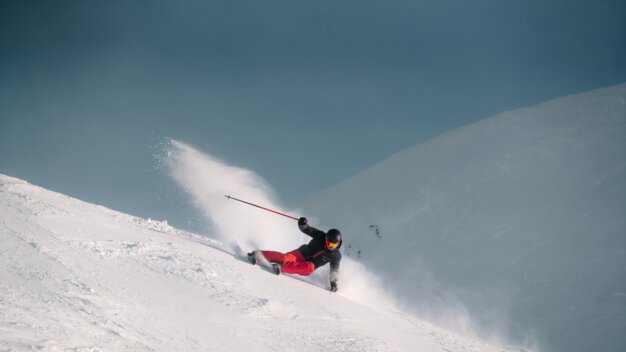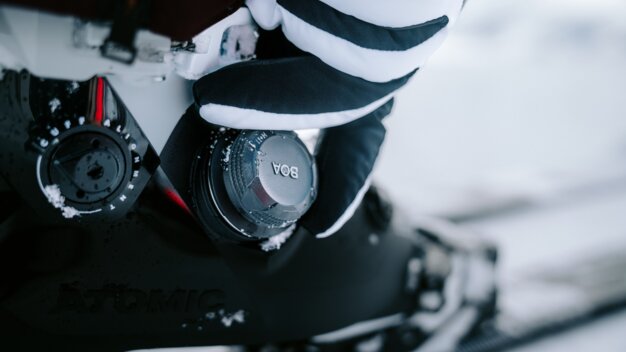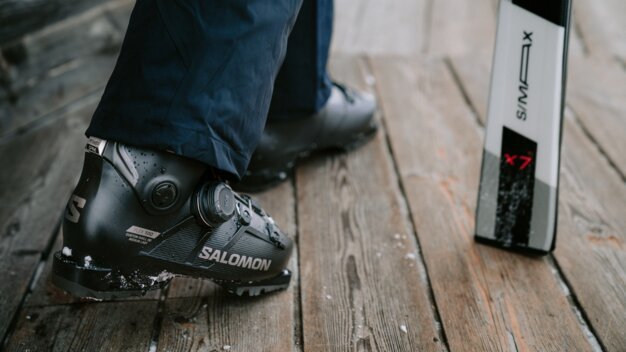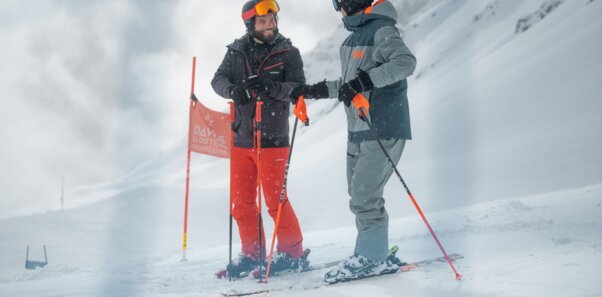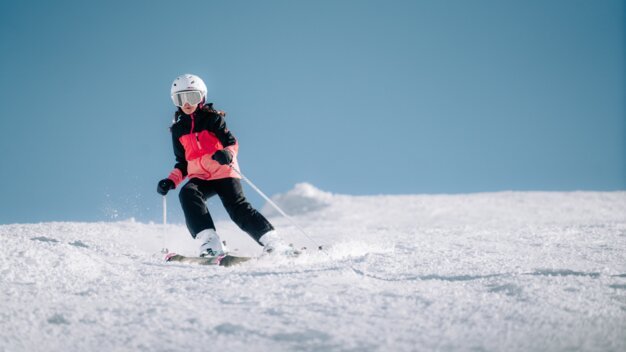
Are you looking for new ski boots and are unsure which model is right for you? Your friends regularly talk about the "flex" of their ski boots and you have no idea what that means?
Don't worry about it! With INTERSPORT Rent you can quickly polish up your winter sports knowledge and learn all about the perfect ski boot flex. Just keep on reading!
Ski boot flex explained: What does the index stand for?
Put simply, the flex value of a ski boot describes its stiffness. The flex therefore provides information about how great the resistance of the boo, when it comes to forward lean. The higher the value, the greater the force to be applied. In general, the flex index is between 60 and 140: The lower the flex, the softer the ski boot, the higher, the harder. Higher flex values are mainly found in ski racing boots. Although this generally makes the ski boot harder and less comfortable, it ensures better power transmission to the ski.
Depending on the ski discipline, it is therefore advisable to consider the flex value as a factor when skiing – regardless of whether backcountry adventures or skiing slopes are on the agenda.
The flex is influenced by various factors in the production of ski boots:
- different materials in the production line of the shell
- different material thicknesses
- overall construction of the ski boot
- number of buckles
- thickness of the strap on the collar
- stiffness of the inner boot
But beware: Even though it may sound like it, the flex index is not a standardised value! Every manufacturer has its own standard. Different brands and categories can differ from each other despite having the same flex value.
This means that a ski boot with a flex of 80 may feel stiffer and less flexible than a boot from another brand with a flex of 100. Nevertheless, the value is a good indicator for comparing range of models from other manufacturers.
Flex index: Soft or hard, which is better for ski boots?
A flex index of 90 or 130 – which is better for ski boots? Well, it depends! First and foremost, you should choose the degree of hardness of your ski boot based on your preferences and individual needs. Firstly, the stiffness of a ski boot only tells you how easily or difficult it is to bend your ankles in the classic skiing position. But: People are different. And so it is easier for one skier to bend their ankles than another.
To determine the right flex value you have to keep the following aspects in mind:
- does it fit your physique
- your weight
- your skiing technique and level
- and the terrain in which you are planning on going
If the boot is too hard, your leg and foot muscles may become tired because they are not used to the strain of direct power transmission. If the boot is too soft, on the other hand, you may simply not be able to transfer the power required for a good performance to the skis. This results in imprecise turns and the fun falls by the wayside. Both high and low flex values have numerous advantages.
The advantages of a soft ski boot
- good for light builds and stiff ankles
- particularly suitable for beginners and leisure skiers
- good cushioning and greater comfort
- easily compensates for minor driving errors and bumps
The advantages of a hard ski boot
- good with a solid build and well-moving ankles
- particularly suitable for technical skiing that requires precise movements
- provides direct feedback and impulses are transmitted immediately, giving you more control over the ski
As you can see, not every flex value suits every winter sports enthusiast. A precise fitting and good advice are therefore paramount when buying ski boots. Nevertheless, there are a few general recommendations.
Ski boot flex rating
The right flex for women's ski boots
| beginners and leisure skiers | 60 to 90 |
| more advanced skiers | 90 to 110 |
| experienced skiers | 110 to 120 |
| competitive athletes | from 130 |
The right flex for men's ski boots
| beginners and leisure skiers | 70 to 90 |
| more advanced skiers | 90 bis 120 |
| experienced skiers and men with a large physique | 120 bis 130 |
| competitive athlete | ab 140 |
The differences in flex between men's and women's ski boots are not due to better or worse ability. Rather, it is a question of physique and the statistical assumption that there are fundamental differences in weight between men and women. And as weight plays a significant role in transferring power to the ski, this is equalised with the help of flex.
The right flex for children's ski boots
- Shoe size between 14 and 21 Mondopoint: No assessment of the degree of hardness
- Shoe size between 22 and 26 Mondopoint: 60 to 90
Tip: The better your child skis, the higher the flex of the ski boot can be selected.
What influences the flex?
As you can see, both your physique and your riding ability are important parameters when choosing the right flex. However, finding the optimum value is not an exact science, even with the most careful selection.
This is because different materials also mean different properties. For example, many plastics are sensitive to temperature. A shoe that feels flexible when you try it on in the shop can suddenly be much stiffer in sub-zero temperatures on the mountain.
In addition to the temperature, other factors also influence the ski boot stiffness of your ski boot:
- Age: Over time, plastics become softer and the stiffness of your ski boot decreases.
- Intensity of use: If you accumulate over 100 days of skiing every season, the material of the ski boot has to work hard. The more often the ski boot is moved, the faster the degree of hardness of your boot decreases.
An important note in this context is that the degree of hardness of your ski boot is not the only factor, when it comes to the right gear. After all, the right skis and bindings are also part of the overall equipment. A ski that is too soft in combination with a hard race ski boot will not deliver the performance you are hoping for.
Tip: If you're not sure whether your ski boots are already too soft, you can simply grab your old boots and compare models in one of our shops . Our RENTertainers will be happy to advise you.
How do you find the right firmness level for you?
There's only one thing to do: Trying! Good expert advice is essential when buying ski boots. But keep in mind that your self-assessment is important as well! Because only if you know about your skiing abilities und can express your needs you will you be able to find the perfect flex for you.
Think in advance about the terrain for which you mainly need the ski boots. It's often a decision between a more precise performance and more comfort. In any case, we hope you have lots of fun skiing.
Frequently asked questions about ski boot flex:
What flex rating does a ski boot have?
Soft ski boots often start with a flex of 60, while boots for competitions are significantly harder and can have a flex of 140 or more. The value itself depends on the material and the construction of the ski boot. To find the perfect ski boot for you, we recommend seeking advice from the winter sports experts at INTERSPORT Rent.
How flexible should a ski boot be?
The flex of a ski boot should always be chosen to match the rider’s ability level. If you want to initiate precise turns on icy slopes or off-piste, you should opt for a stiff ski boot, because it’s better to transmit the power of movement impulses.
If you value comfort more, you will prefer ski boots with a lower flex.
Where can I find the flex on ski boots?
The flex of a ski boot can usually be found on the outer shell of the boot. The value is either engraved or printed there. If not, the flex is usually noted on the dealer page for the appropriate model.
Does the flex change with the age of the ski boot?
Yes, the flex of your ski boot will become softer over time. This is due to the plastics used in their manufacture. The more a ski boot is used, the more flexible it becomes – so the hardness of the material decreases over time. This affects its overall performance.
It's best to take your current ski boot to an INTERSPORT Rent shop. This way, you can compare – with the help of our RENTertainers – the flex of your boot in comparison to a new model with identical settings.
INTERSPORT Rent Tip
Our INTERSPORT RENTertainers are true winter sports experts. The right flex in ski boots, stiffness is their daily business. Let them advise you on site and simply test several boots to get a feel for the different degrees of hardness.
The best way to find the perfect ski boots for your next slope adventure is to visit one of the numerous INTERSPORT Rent shops – many of which are right at the bottom of the slope – and get advice from the professionals!
